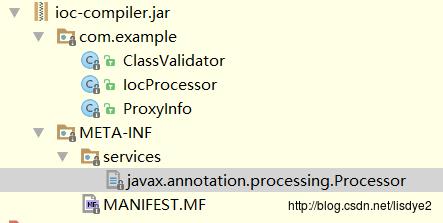手动实现IOC框架,与findViewById说拜拜
Posted Alex_MaHao
tags:
篇首语:本文由小常识网(cha138.com)小编为大家整理,主要介绍了手动实现IOC框架,与findViewById说拜拜相关的知识,希望对你有一定的参考价值。
手动实现IOC框架,与findViewById说拜拜
转载请标明出处:
http://blog.csdn.net/lisdye2/article/details/64233563
本文出自:【Alex_MaHao的博客】
项目中的源码已经共享到github,有需要者请移步【Alex_MaHao的github】
自序
在开发android中,总要写许多的findViewById方法,这无疑是一件非常痛苦的事情。直到接触了Xutils框架,发现竟然可以使用注解的方式,优雅的干掉了findViewById方法,当时真是惊为天人。后来遇到了Butterknife之后,发现不仅能够通过实现findViewById方法,甚至连setOnClickListener,getString(),getResource()方法,都能通过一行注解的方式快速的实现。
当时在使用过程中,感觉这种方式大大的提高了开发的效率,以及编码的舒畅度,自己很有必要实现以下。于是便有了这篇博客,该篇博客主要实现了findViewById方法,虽然广度不是很大,但他们的原理都是相同的。
如何使用
使用方式和Butterknife相似,通过注解@BindView标识控件,通过ViewFinder.inject(this)实现代码的注入。
public class MainActivity extends AppCompatActivity {
// 通过注解绑定控件
@BindView(R.id.text)
TextView textView;
@Override
protected void onCreate(Bundle savedInstanceState) {
super.onCreate(savedInstanceState);
setContentView(R.layout.activity_main);
//代码注入
ViewFinder.inject(this);
textView.setText("123");
}
}
实现原理
实现方式有两种
通过反射实现:如果对于反射有深入了解,则应该清楚,我们可以通过反射获取到该注解,并且获取到该注解的值等等一系列的必须量,通过反射我们实现对控件的注入。该方法虽然可以实现,但对效率有着一定的影响。毕竟反射很影响效率。
通过编译器生成代码实现:在我们运行java代码的时候,通常先通过javac将java文件编译成.class文件,然后运行class文件,那么我们能不能够在编译时期,根据我们的注解生成findViewById等方法,这样我们就能够在运行期查找控件。结果当然是可以的,本例就是使用这种方式。因为虽然其使用的是注解,但在运行期其实质仍是通过findViewById方法查找控件,相比于反射来说,大大的提高了性能。
通过编译器生成代码的大致流程如下:
- 编写
Modul:ioc-annotation,该工程主要定义注解@BindView用以修饰变量。 - 编写
Modul:ioc-compiler,该工程为最终会打成jar包,主要是在javac编译时期根据注解生成注入代码的相关类 - 编写
Modul:ioc-api,该工程主要提供注入的调用方法ViewFidder.inject(),调用代码注入的方法。 - 编写
Modul:app,测试工程。
代码实现
根据上面的流程,开始实现框架
编写ioc-annotation模块
该模块比较简单,就是定义一个注解。如下:
@Retention(RetentionPolicy.CLASS)
@Target(ElementType.FIELD)
public @interface BindView {
int value();
}
该注解主要有两个功能:
- 在
Activity中修饰变量,用以标识需要findViewById的相关控件。 - 在
ioc-compiler模块中,用以检索和获取需要findViewById的控件。
编写ioc-compiler模块
在之前我们提到过,该框架的原理是在编译时期根据我们的要求生成注入的辅助代码,那么如何生成,以何种规则生成,肯定是由我们来定义的。
javac命令中,可以在其编译的指定目录放入一个.jar文件,当然这个.jar文件有特殊的要求(后面再说),这样运行javac命令之前,javac会调用jar,通过这种特性订制一些我们想实现的功能。
那么看一下该模块的关键类IocProcessor
@AutoService(Processor.class)
public class IocProcessor extends AbstractProcessor {
// 文件相关的辅助类,生成JavaSouceCode
private Filer mFileUtils;
private Elements mElementUtils;
// 日志相关
private Messager mMessager;
private Types mTypeUtils;
@Override
public synchronized void init(ProcessingEnvironment processingEnvironment) {
super.init(processingEnvironment);
mTypeUtils = processingEnvironment.getTypeUtils();
mFileUtils = processingEnvironment.getFiler();
mElementUtils = processingEnvironment.getElementUtils();
mMessager = processingEnv.getMessager();
}
/**
* 标示该处理器捕获处理的注解类型
*/
@Override
public Set<String> getSupportedAnnotationTypes() {
Set<String> annotationTypes = new LinkedHashSet<>();
// getCanonicalName 获取规范的名字
annotationTypes.add(BindView.class.getCanonicalName());
return annotationTypes;
}
/**
* 指定使用的java版本,一般默认支持返回最新
* @return
*/
@Override
public SourceVersion getSupportedSourceVersion() {
return SourceVersion.latestSupported();
}
private Map<String, ProxyInfo> mProxyMap = new HashMap<>();
/**
* 相当于main 函数,处理扫描,评估和处理注解的代码以及生成java文件
* @param set
* @param roundEnvironment 用于查询包含特定注解的注解元素
* @return
*/
@Override
public boolean process(Set<? extends TypeElement> set, RoundEnvironment roundEnvironment) {
//.....关键处理代码
return true;
}
}
为了方便浏览,暂时删去了一些代码。
首先在类的声明上,我们添加了一个注解@AutoService,该注解是由Google提供的用于生成.jar包的相关注解。使用该注解需要添加依赖com.google.auto.service:auto-service:1.0-rc3,在这里有一个疑问,为什么要使用该注解呢,生成的jar包邮什么特殊的地方吗?
因为该jar包是提供于注解时期的,所以其有特殊的目录形式:

除了有最基本的类以外,多了META-INF的service目录,该目录中的文件命名是固定的,其内容很简单
com.example.IocProcessor就一行内容,标明主要的处理类。而如果我们手动编写jar的目录很麻烦,所以Google提供了一个@AutoService,用以直接实现这种目录形式的jar包。
看完注解之后,看类声明,继承AbstractProcessor,实现三个方法:
getSupportedAnnotationTypes:获取注解支持的类型,在此,我们支持BindView,没有什么疑问getSupportedSourceVersion:指定使用的java版本,一般默认支持返回最新,默认此写法,没什么问题。process:处理注解的主要方法,主要在此方法中实现对相关类的处理。
那么看一下process的实现:
private Map<String, ProxyInfo> mProxyMap = new HashMap<>();
/**
* 相当于main 函数,处理扫描,评估和处理注解的代码以及生成java文件
* @param set
* @param roundEnvironment 用于查询包含特定注解的注解元素
* @return
*/
@Override
public boolean process(Set<? extends TypeElement> set, RoundEnvironment roundEnvironment) {
mProxyMap.clear();
// --------------------检索注解,保存包含注解的类以及需要注入的成员变量-------------------------
// 该方法获取的element是被注解标注的所有元素,所以需要检查
Set<? extends Element> elements = roundEnvironment.getElementsAnnotatedWith(BindView.class);
for (Element element : elements) {
// 检查element的类型
if (!checkAnnotationValid(element, BindView.class)) {
return false;
}
VariableElement variableElement = ((VariableElement) element);
TypeElement typeElement = (TypeElement) variableElement.getEnclosingElement();
// 全路径名
String qualifiedName = typeElement.getQualifiedName().toString();
// 类信息
ProxyInfo proxyInfo = mProxyMap.get(qualifiedName);
if (proxyInfo == null) {
proxyInfo = new ProxyInfo(mElementUtils, typeElement);
mProxyMap.put(qualifiedName, proxyInfo);
}
// 在类信息中保存需要注入的成员变量和id
BindView annotation = variableElement.getAnnotation(BindView.class);
int id = annotation.value();
proxyInfo.injectVariables.put(id, variableElement);
}
// ---------------- 生成对应的类----------------------------
for (String key : mProxyMap.keySet()) {
ProxyInfo proxyInfo = mProxyMap.get(key);
try {
// processingEnv : 注解处理环境(工具类),提供很多有用的功能工具类
JavaFileObject jfo = processingEnv.getFiler().createSourceFile(
proxyInfo.getProxyClassFullName(),
proxyInfo.getTypeElement());
Writer writer = jfo.openWriter();
writer.write(proxyInfo.generateJavaCode());
writer.flush();
writer.close();
//----- 在生成类之后gradle会对代码进行优化
} catch (IOException e) {
error(proxyInfo.getTypeElement(),
"Unable to write injector for type %s: %s",
proxyInfo.getTypeElement(), e.getMessage());
}
}
return true;
}
自上而下分析:
- 首先获取被注解
@BindView修饰的元素,注意此时获取的元素可能是TypeElement,VariableElement,ExecuteableElement等,不一定确定是成员变量,所以要做一层检查。
检查的方法如下
/**
* 检查查找的元素是否合法
*/
private boolean checkAnnotationValid(Element annotatedElement, Class clazz) {
if (annotatedElement.getKind() != ElementKind.FIELD) {
error(annotatedElement, "%s must be declared on field.", clazz.getSimpleName());
return false;
}
if (ClassValidator.isPrivate(annotatedElement)) {
error(annotatedElement, "%s() must can not be private.", annotatedElement.getSimpleName());
return false;
}
return true;
}
// 展示错误信息
private void error(Element element, String message, Object... args) {
if (args.length > 0) {
message = String.format(message, args);
}
mMessager.printMessage(Diagnostic.Kind.NOTE, message, element);
}
- 其次:获取到需要生成辅助类的类(含有注解
@BindView的类),并保存类信息到ProxyInfo中,同时保存被注解的成员变量到该ProxyInfo中,以Map的形式保存,键是注解的值,value是被注解的元素。到这里会好奇什么是辅助类,他是什么形式的,我们看一下最终生成的辅助类就会清晰了
// 依赖注入生成的辅助类,最终调用inject()方法,实现注入
public class MainActivity$$Finder implements Finder<MainActivity> {
public MainActivity$$Finder() {
}
public void inject(MainActivity host, Object source, Provider provider) {
// 依赖注入的具体实现
host.textView = (TextView)((TextView)provider.findView(source, 2131492945));
}
}
生成的辅助类很清晰,看一眼即可,此时多看会模糊,我们只要确定我们要生成如上格式的类就行了。
- 保存了类以及注解的相关信息之后,便是生成代码,循环
mProxyMap获取相关类,生成代码,其实就是通过流写文件,关键的实现writer.write(proxyInfo.generateJavaCode());,其中调用了proxyInfo.generateJavaCode()用以生成代码,看一下实现
// 生成java 代码
public String generateJavaCode() {
StringBuilder builder = new StringBuilder();
builder.append("// Generated code. Do not modify!\\n");
builder.append("package ").append(packageName).append(";\\n\\n");
builder.append("import com.mahao.ioc_api.*;\\n");
builder.append('\\n');
builder.append("public class ").append(proxyClassName).append(" implements " + ProxyInfo.PROXY + "<" + typeElement.getQualifiedName() + ">");
builder.append(" {\\n");
// 添加inject()方法
generateMethods(builder);
builder.append('\\n');
builder.append("}\\n");
return builder.toString();
}
// 生成注入的方法
private void generateMethods(StringBuilder builder) {
builder.append("@Override\\n ");
builder.append("public void inject(" + typeElement.getQualifiedName() + " host, Object source, Provider provider) {\\n");
for (int id : injectVariables.keySet()) {
VariableElement element = injectVariables.get(id);
String name = element.getSimpleName().toString();
String type = element.asType().toString();
builder.append("host." + name).append(" = ");
builder.append("(" + type + ")(provider.findView( source," + id + "));\\n");
}
builder.append(" }\\n");
}
- 上面的两个方法可能有一点复杂,但逻辑不是很绕。
- 最终我们编写完了在编译期需要用到的
jar。可以看到其主要目的是为了生成xxx$$Finder的辅助类的。
编写ioc-api模块
有了标识,也有了编译时期的jar包,最终也生成了xxx$$Finder的辅助类,那么久剩下最后的调用了。
根据我们最开始的使用方法ViewFinder.inject()可知,肯定要从这里看起。
public class ViewFinder {
private static final ActivityProvider PROVIDER_ACTIVITY = new ActivityProvider();
private static final ViewProvider PROVIDER_VIEW = new ViewProvider();
/**
* 从activity 注入
* @param activity
*/
public static void inject(Activity activity) {
inject(activity, activity, PROVIDER_ACTIVITY);
}
/**
* 从View 中查找
* @param host
* @param view
*/
public static void inject(Object host, View view) {
// for fragment
inject(host, view, PROVIDER_VIEW);
}
// 注入的最终调用
public static void inject(Object host, Object source, Provider provider) {
Class<?> clazz = host.getClass();
String proxyClassFullName = clazz.getName()+"$$Finder";// 根据传入的对象获取辅助类的全路径名
Class<?> proxyClazz = null;
try {
proxyClazz = Class.forName(proxyClassFullName);// 获取辅助类的class
Finder viewInjector = (Finder) proxyClazz.newInstance(); // 生成辅助类的实例
viewInjector.inject(host, source, provider); // 调用辅助类的inject()方法
}catch (Exception e) {
e.printStackTrace();
}
}
}
可以看到,最终的inject()实现方法。因为在生成辅助类的时候,我们是根据类名+$$finder的固定写法,所以很容易的通过class的形式生成辅助类的实例化,并调用inject方法。在这里出现了Finder对象,他实际是我们定义的接口
public interface Finder<T> {
void inject(T host, Object source, Provider provider);
}辅助类在生成代码时,统一继承该接口,便于调用inject()方法(多态).
注意,此时可以看一下viewInjector.inject(host, source, provider);方法,在看一下生成的辅助类
public class MainActivity$$Finder implements Finder<MainActivity> {
// 看这里,有没有发现什么
public void inject(MainActivity host, Object source, Provider provider) {
host.textView = (TextView)((TextView)provider.findView(source, 2131492945));
}
}
有没有感觉到一种抓住了什么的感觉,再仔细看一下ViewFinder类,提供了两个inject()方法,分别是从Activity中注入,一种是从View中注入,为什么从View中注入,我们需要多传入一个Object对象呢?
仔细观察发现:
host其实是我们成员变量所在的类source:findViewById操作的类,即source.findViewByIdprovider: 对findViewById的一层封住,便于处理Activity和View两种情况。
最终,整个框架到这里就完全的串联起来了
最后的最后,我们需要添加ioc-compiler到我们的编译时期,这时需要借助gradle的一个脚本android-apt,用以达到在编译期添加工程依赖。详细过程不写了,可以看我的github上的源码。github地址已在文章顶部贴出。
总结
通过以上的流程可以发现,我们在编译期生成辅助类用以完成findViewById的操作。那么根据这个原理,实现setOnClickListener等,基本上和这些事类似的。甚至基于这种思路,我们完全可以做更多的事情。
以上是关于手动实现IOC框架,与findViewById说拜拜的主要内容,如果未能解决你的问题,请参考以下文章